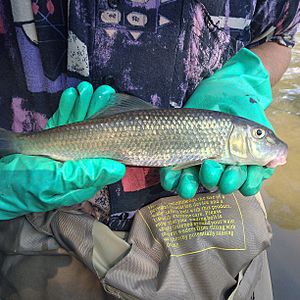Black redhorse facts for kids
Quick facts for kids Black redhorse |
|
|---|---|
 |
|
| Black redhorse in the Huron River, Ohio | |
| Conservation status | |
| Scientific classification | |
| Synonyms | |
|
The black redhorse (Moxostoma duquesnei) is a type of freshwater fish. It lives in streams and rivers in Ontario, Canada, and the eastern United States. This fish is a bottom-feeder, meaning it finds its food on the riverbed. It eats tiny crustaceans, water insects, dead plant matter, and algae.
Black redhorse fish lay their eggs in the spring. This species is considered "Threatened" in Canada. This means its population is at risk, and efforts are being made to protect it.
Contents
What Does a Black Redhorse Look Like?
The black redhorse belongs to the sucker family, called Catostomidae. It has a flat body from side to side. Its back is not very arched. Almost half of its head is a long, rounded snout. Its mouth is on the underside of its snout. It has a thick lower lip.
The fish's body is usually silvery-blue. Its back is gray or brownish. Its belly is silver or white. Some of its scales have dark edges. During the breeding season, male black redhorse fish look different. They get dark stripes and orange or pink colors on their sides. They also grow small bumps called nuptial tubercles on their tail fins.
You can tell a black redhorse apart from similar fish. It does not have red on its tail. Also, its lips are smooth, without grooves.
Where Do Black Redhorse Fish Live?
The black redhorse lives in many places across eastern North America. You can find them from Alabama and Mississippi in the south. They also live as far north as Ontario and Michigan. In the east, they are in New York. In the west, they reach Oklahoma and Minnesota.
In Canada, they are only found in southwestern Ontario. They live in just six different river systems there. These include the Bayfield, Maitland, and Ausable Rivers. They are also in the Grand River and Thames River watersheds.
What Kind of Home Do They Like?
Black redhorse fish usually live in medium-sized rivers and streams. These waterways are typically 25 to 130 m (82 to 427 ft) wide. They can be up to 1.8 m (5 ft 11 in) deep. The water usually flows at a moderate to fast speed. You rarely find them where there are lots of water plants.
They prefer river bottoms made of rocks, gravel, sand, or silt. In the summer, they like to stay in deeper pools. They also spend the winter in these deep pools. In the spring, black redhorse fish travel to places where they can lay eggs. They lay their eggs in fast-flowing parts of the river called riffles. This happens when the water temperature is between 15 and 21 °C (59 and 70 °F). They lay eggs on different types of riverbeds. These can range from fine gravel to large rocks. Their eggs are not sticky. They are about 2.6 to 2.9 mm (0.10 to 0.11 in) in size.
Black redhorse fish become adults when they are two to six years old. How long they live depends on where they are. Some fish can live up to 16 years.
What Do Black Redhorse Fish Eat?
Adult black redhorse fish are bottom feeders. They mainly eat small crustaceans and insects. Younger fish, those smaller than 65 mm (2.6 in), eat tiny floating organisms called plankton.
Why Are Black Redhorse Fish Important?
Human activities can affect the places where black redhorse fish live. Things like city growth and farming can cause problems. They can make the water cloudy with silt. They can also change how fast the water flows. This makes it harder for the fish to find good homes.
The black redhorse needs specific places to lay its eggs. Changes in water flow can harm their ability to have babies. Dams on rivers can also block the fish from moving freely. Sometimes, people fishing for sport accidentally catch black redhorse. This can also impact their numbers. The largest black redhorse ever caught was 1.02 kg (2 lb 4 oz). It was caught in Pennsylvania in 1998.



